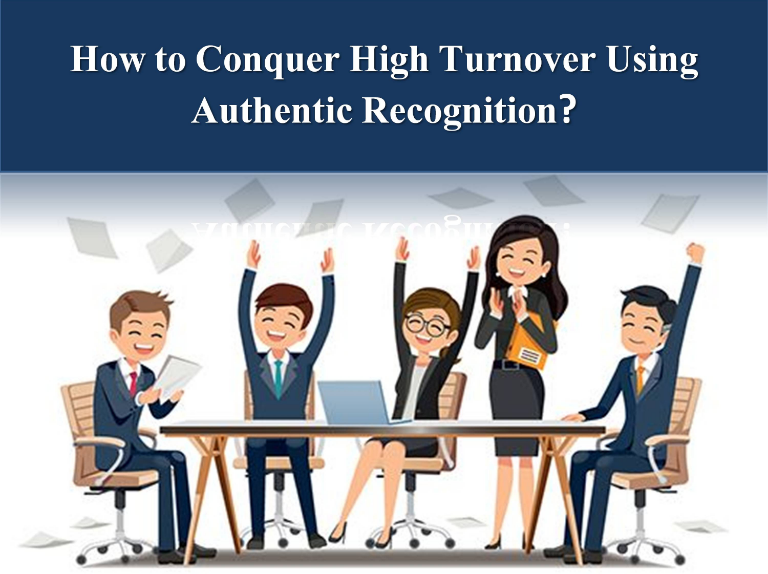How to conquer high employee turnover

How to conquer high Employee turnover using Authentic Recognition
High attrition rate in companies have become a global phenomenon these days. Organizations are dealing with this issue in their own traditional or innovative ways. Some are able to tame the dragon others are still lurking in the dark to find out a way that works best for them. Decades ago employees used to remain employed in the same organization for 30-40 years. Company loyalty was a sought after virtue, employees & organization went past their call of duty to nurture the same. Employees stuck to their job roles and companies made available lots of employee welfare & retirement benefits. Look at how our parents & grandparents treated their jobs (& employers) as sacrosanct.
Now-a-days trend has reversed. Employees stay with a company for approx. 4 years. They change around 12 companies over their lifetime. Even companies have started acknowledging this fact and started devising strategies to plug in the turnover rate. Extensive management research has been done in this area and surprisingly enough one of the major factors influencing attrition issue is employee recognition. Let us see how employee recognition affects attrition, how attrition is detrimental, what companies have done, where is the gap and what can be done.
Employee recognition has been here for a while. Majority of businesses acknowledge that people are the main assets of any organization, even more so for service industry such as software where thousands of people might be employed in a single organization. Most of the companies have implemented some form of employee recognition policy. Despite that it seems that as large as 40% of employees seem to be under appreciated. Question arises that where is the gap.
Many managers intend to recognize their team members but they don’t know the right way of executing employee recognition programs. This prevents building organization wide recognition culture and people feel underappreciated for the good work they have done. Obviously this impacts employee morale, employee engagement & finally employee productivity. Employees don’t get the sense of purpose of what they are doing and with lack of meaningfulness comes the unescapable conclusion of changing job, doing something meaningful that impacts life of others. According to a study, turnover can costs a company approx. 50% to 250% of departing member annual salary. Naturally it is a huge cost and top management are trying their level best to rein in the trend.
In a flourishing economy attrition becomes even more accentuated as more jobs become available, technology enables remote work opportunities and thus employees becoming more selective of job offers. Candidates know they can find jobs out in the market that suits their professional & personal goals.
Employee recognition has many other benefits for the organization apart from reducing attrition rates and company cost. A well though & implemented employee recognition policy can raise employee productivity by as much as 30%. Satisfied employees are more happy and hence more productive. Another aspect that gets positively impacted by employee recognition is employee engagement. In a recent study it was found that 80% of HR managers gave importance to enhancing employee engagement & 60% of thought leaders believed that employee recognition is the key to employee engagement.
Employee recognition should be carefully crafted. HR managers & line managers should come out with recognition programs that are specific & have well defined frequency. Note that not all programs are the responsibility of HR department. At ground levels there are many team specific KPIs that need to be monitored & improved. Hence HR team will be not in a position to have visibility of those areas. Here comes the importance of line managers. They should start local recognition programs with defined criteria, objectives & reward frequency. A part of Opex cost can be earmarked for such activities.
Let us now look at various ways in which you can get your employee recognition efforts right. First of all prioritize your efforts. Employee recognition not often ranks high in the to-do list of business requirements. Increasing revenues & bottom line take up the major share of focus. But believe me top performing businesses have kept employee recognition high in their agenda. Secondly, check the pulse of your team. What motivates them more – is it applaud in town hall or a recognition certificate, appreciation mail from top management, or is it more of tangible rewards such as gift coupons, gym membership, branded merchandise etc. Ideally it should be a balanced mix of all of the above. Giving only verbal appreciation or only monetary rewards doesn’t work. Monetary rewards should be meaningful for employees and should not look as if they are given for the sake of giving. E.g. sponsor a professional development certification. Risk with monetary reward is that people often judge their work contribution by the value of reward.
Thirdly, enable peer to peer recognition. Recent studies have shown that peer to peer recognition works more for employee satisfaction rather that manager-only recognition. Set up a platform where people can exchange positive feedback & line managers should acknowledge them in public forums as far as possible. E.g. one of the largest business conglomerate in India has introduced ‘smileys’ that colleagues can present to each other with a short description of why this is being given. Often the presenter involves line managers or other senior guys while the smiley is being handed over. Being innovative & creative also matters. Make recognition a fun activity. Theme based recognition can also work- e.g. an Avengers styled recognition in current month. Lastly, try to recognize personal achievements such as completing an MBA, building a home, exceling in sports etc. This will foster a closer emotional connect with employees and will induce employees to give their fullest to work.


